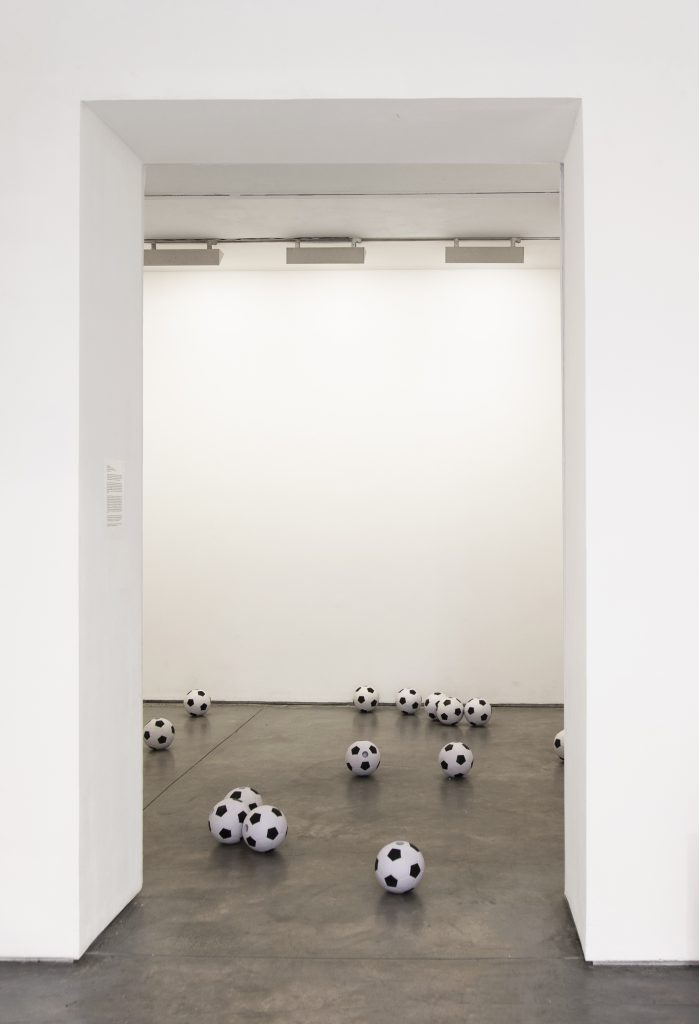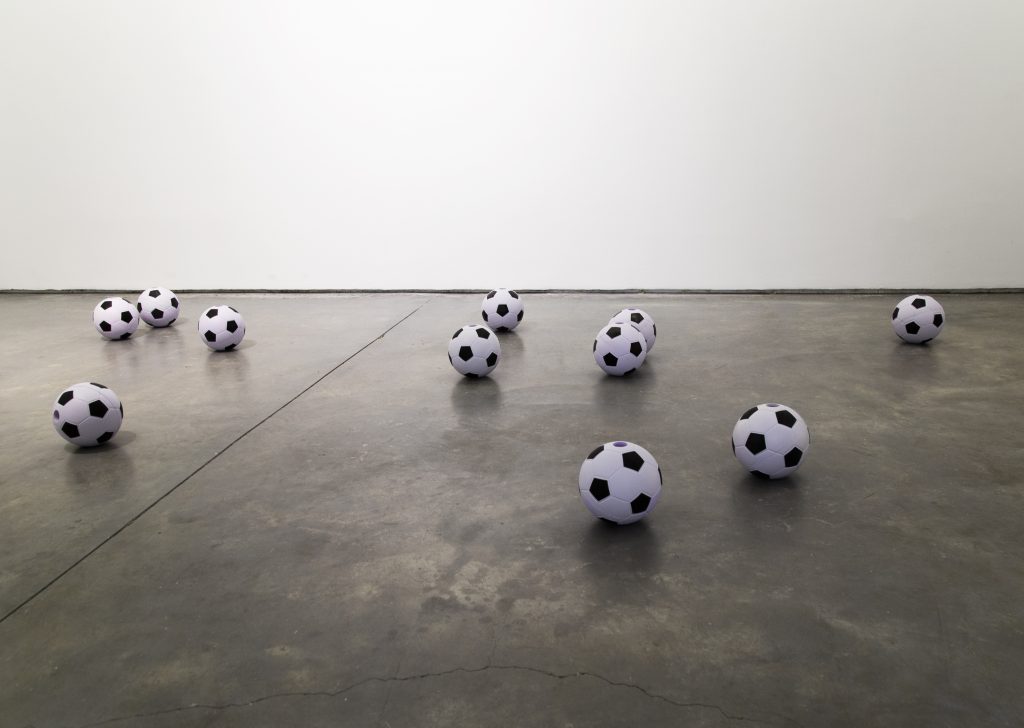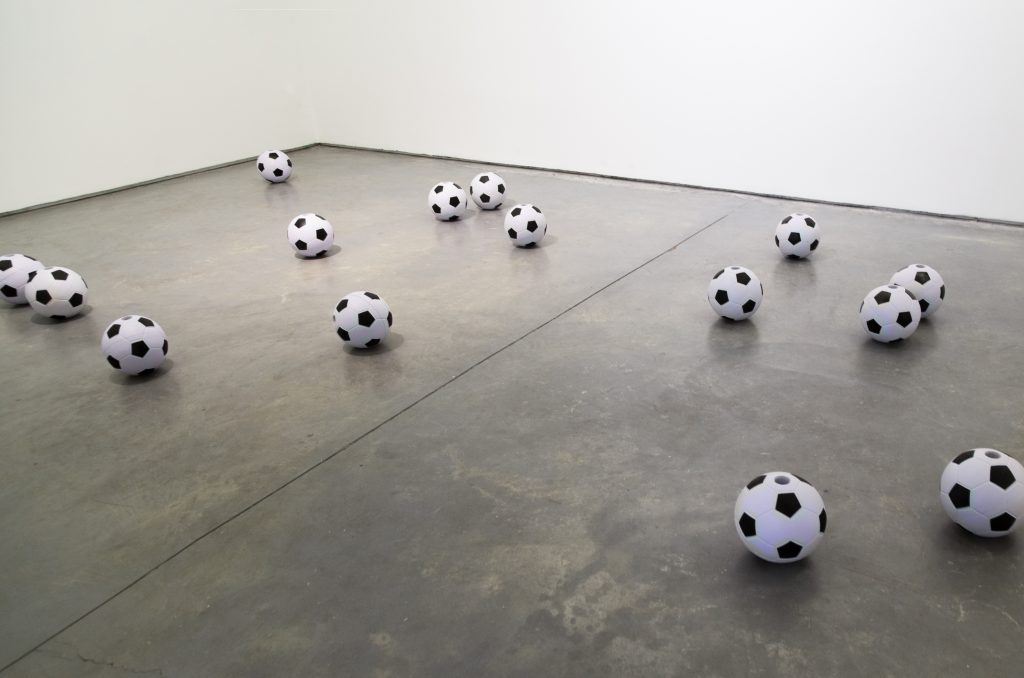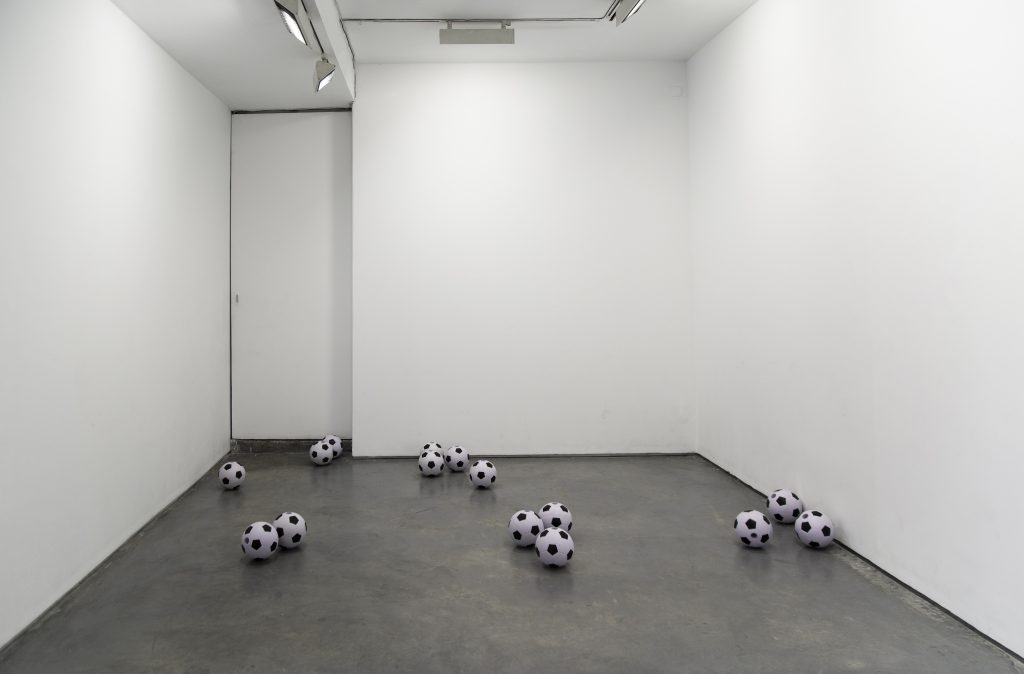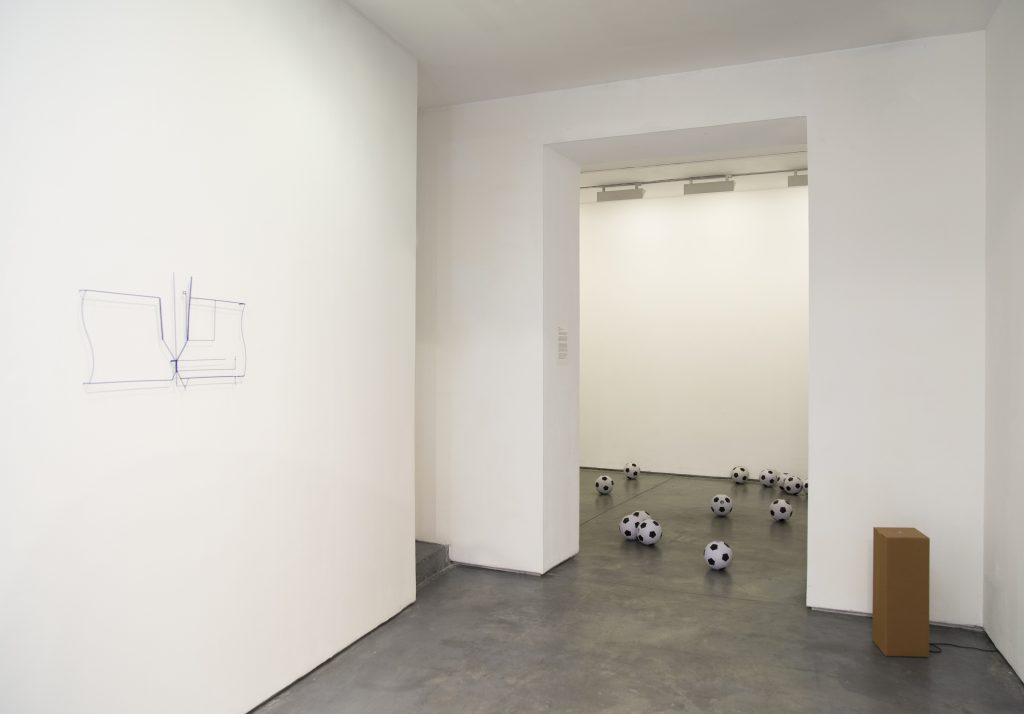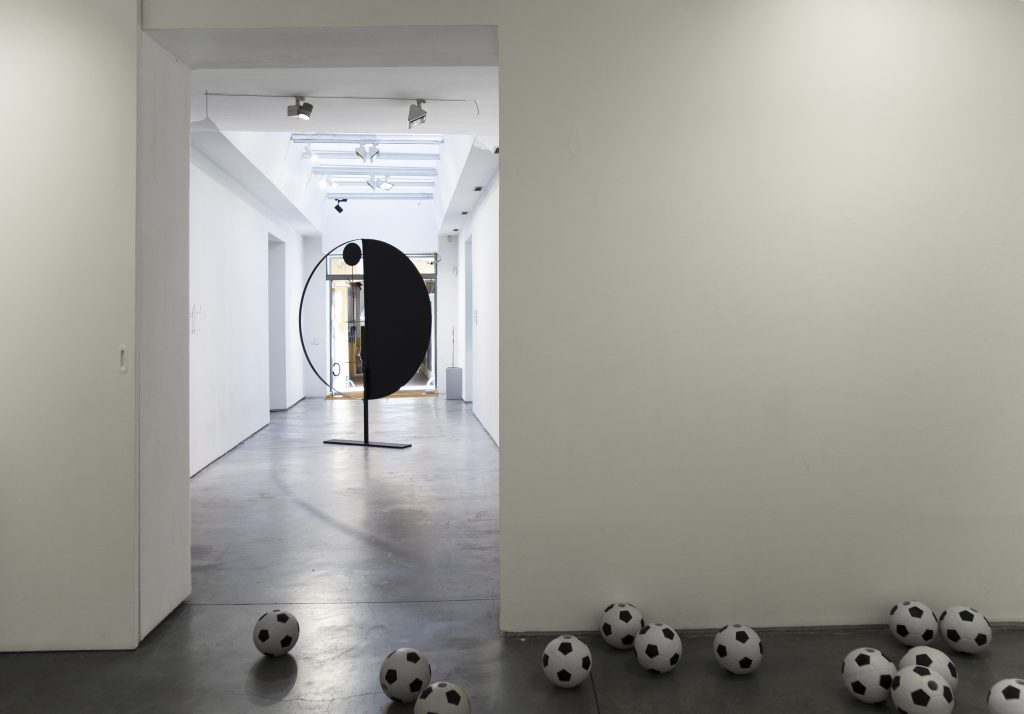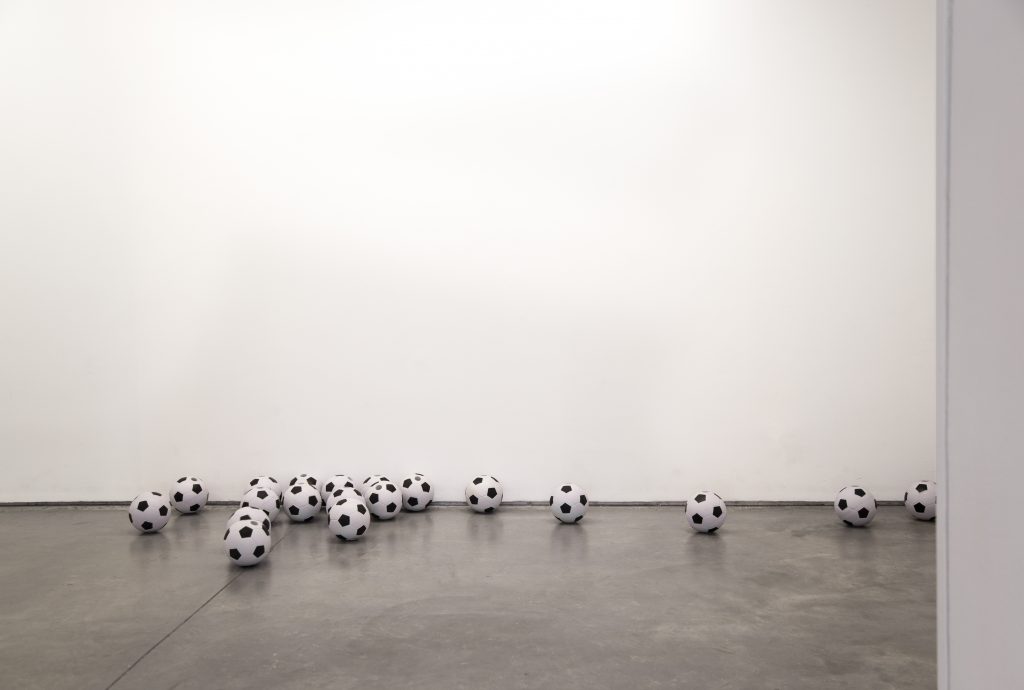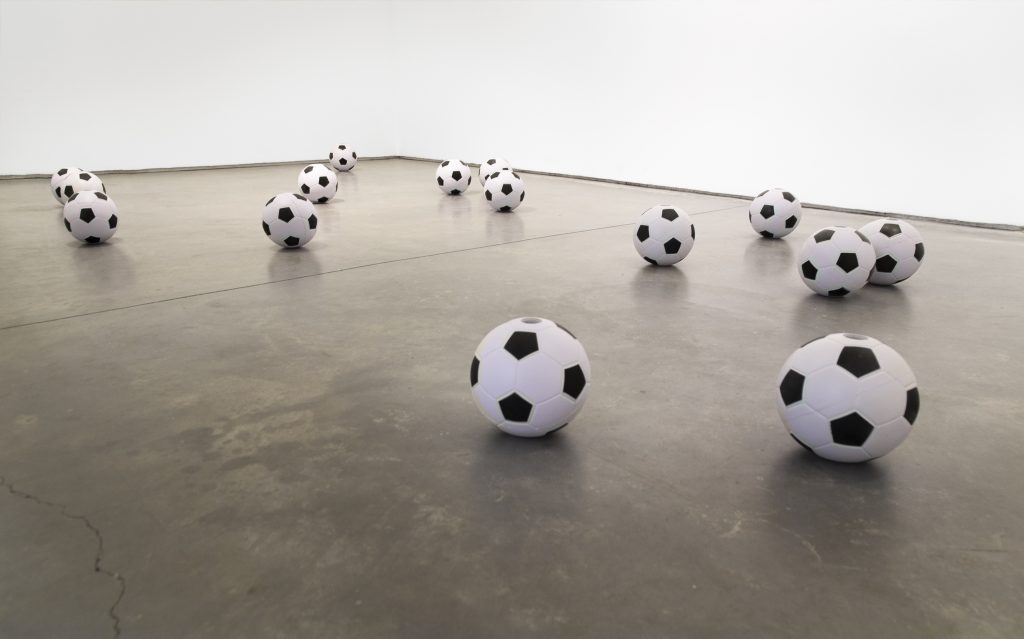Arturo Moya (2020-23)
Diseño de hardware y firmware: Riley García
Voz: Elena Anaya
Comisario: Gregorio Cámara Castellanos
(english below)
Galería Max Estrella. Abril-Julio 2023
https://maxestrella.com/es/exhibition/el-dia-que-el-universo-cambio/
(english below)
Descripción:
Instalación sonora interactiva
22 pelotas se encuentran diseminadas por la sala. Cada pelota posee un altavoz en su interior acoplado a un dispositivo electrónico capaz de detectar el movimiento. Cuando recibe una patada el audio se pone en funcionamiento y es difundido por la sala con el propio movimiento de la pelota. El audio cesa cuando la pelota se detiene.
Los audios corresponden a sonidos grabados procedentes de la lectura de fragmentos de la tesis de 1939 de Mary Tudor: “An experimental study of the effect of evaluative labeling of speech fluency” (Un estudio experimental del efecto del etiquetado evaluativo sobre la fluidez del habla). La tesis trataba de demostrar la importancia del refuerzo positivo o negativo en el desarrollo de la tartamudez. Fue conocida más adelante como el “Monster Study” o «Monster Experiment», por su ausencia de consideraciones éticas al inducir la tartamudez, en algunos casos de por vida, a niñxs y chicxs fluentes. Lxs niñxs utilizados en el estudio eran huérfanos que procedían de la Casa de Soldados y Marineros Huérfanos en Davenport, Iowa.
Las partes que se han utilizado de la tesis corresponden a las transcripciones de las entrevistas que la misma autora mantuvo con los 22 sujetos sometidos al estudio. 22 pelotas, una por cada infante.
Más información sobre el caso AQUÍ
Concepto:
La preocupación sobre la tartamudez como una forma de violencia sobre el propio habla, ya fue tratada previamente por el autor en el proyecto “Violencias del decir I”, una instalación sonora site-specific, que presentaba voces de personas con disfemia. En el presente proyecto, la violencia aparece bajo la forma de una voz -la autora del estudio- que, investida de cercanía y autoridad, busca provocar tartamudez en una voz otra.
En el estudio creemos que se evidencian algunas formas insoportables de dominación que habitan nuestra cultura de forma silenciosa; las condiciones de posibilidad de la tesis vienen dadas por una razón que permite y avala la desaparición del otro. Como proponía Levinas: “la esencia es el sincronismo extremo de la guerra”, o dicho de otro modo, las preocupaciones recurrentes de la filosofía, el ser, la esencia, el tiempo, etc. ignoran al otro, lo que desemboca irremediablemente en violencia contra él/ella. El giro ético de las esencias al otro al que se refiere Levinas habría impedido la investigación de Mary Tudor.
La instalación propone un acercamiento lúdico, pero no exento de crítica. La identificación -cosificación- de cada niño con un balón -uno de los objetos de juego infantil más extendido-, nos habla de una de las violencias específicas del arte: la sustitución y la apertura de la metáfora.
La cooperación necesaria y voluntaria del visitante en la actualización de la violencia ejercida en el desarrollo de la tesis, lo hace cómplice de una violencia que reaparece en cada palabra devuelta a la vida en los desplazamientos de las pelotas por el espacio de exhibición.
La misma violencia de la patada añade su propio estrato violento a la obra, al establecer una relación de violencia necesaria entre la obra y el visitante, pues la obra únicamente existe porque es golpeada. La patada, además, emparenta la obra con los deportes de masas, claramente receptores de violencias desviadas, como sucede con el habla según la tesis del marco de trabajo «Violencias del decir» en el que se inserta este proyecto.
Toda la documentación técnica sobre el proyecto aquí:
https://github.com/ex-arte-electronico-y-experimental/acustic-impact-ball
Fotos: Max Estrella
Arturo Moya (2020-23)
Hardware and Firmware Design: Riley García
Voice: Elena Anaya
Curator: Gregorio Cámara Castellanos
Max Estrella Gallery. April-July 2023
https://maxestrella.com/es/exhibition/el-dia-que-el-universo-cambio/
Description:
Interactive sound installation.
Twenty-two balls are scattered around the room. Each ball houses a loudspeaker inside, connected to an electronic device able to detect movement. Kicking them triggers an audio recording, diffused around the space like the moving ball itself. When the ball stops, the audio stops.
The audio files consist of recorded readings of fragments of Mary Tudor’s 1939 thesis An Experimental Study of the Effect of Evaluative Labelling of Speech Fluency. This thesis became known later as ‘Monster Study’, for its lack of ethical consideration when inducing, in some cases lifelong, stuttering in fluent-speaking children. The subjects of her study were orphans from the Orphan Soldiers and Sailors Home in Davenport, Iowa. The parts of the thesis used in this piece correspond to transcriptions of interviews that Tudor herself had with the 22 girls and boys subjected to the experiment. 22 balls, one per child.
Concept:
Some concerns with stuttering as a form of violence on speech itself were explored on the author’s previous project, Violencias del decir I. The project, a site-specific sound installation developed for a cultural arts centre building, showed recordings of stutterers’ voices talking about their own speech. These sounds were hidden in the structure of the building and could only be heard when visitors put their ears directly on the building’s surfaces, encouraging a listening activity similar to eavesdropping through a wall. The stuttering voices linked their own communicative difficulties with the various ways in which a cultural centre speaks to citizens, which invited to reflect on art’s modes of expression.
The current project again deals with stuttering, but this time violence takes on the form of a voice – that of the author of the experiments –, attempting to induce stuttering in other voices, just to prove a hypothesis. We believe these experiments show some unbearable forms of oppression which quietly inhabit our culture; the thesis is made possible by an underlying reasoning that endorses and allows such research but disregards the harm endured by its subjects. Tudor’s thesis represents a model of thought which reflects Levinas’ diagnosis: “essence is the extreme synchronism of war”, or in other words, recurrent themes in philosophy – the being, essence, time, etc– disregard the ‘other’, and such disregard can only breed war. The study accurately exemplifies this model of thought where the ‘other’ is simply something to be controlled. Levinas’ ethical spin on essence towards the ‘other’ would have prevented Mary Tudor’s research. The installation presents a playful, but still critical, approach to these questions. The reified one-to-one relationship between children and balls – which are one of the World’s most wide-spread playing objects – suggests a characteristic kind of violence in art: substitution and the use of metaphor.
Visitors become accomplices of the violence in every word awakened by the balls’ movement around the exhibition space through their cooperation, as voluntary as it is necessary for a revision of the violence exerted during the experiments. The piece receives an extra layer of violence through the kicking action, establishing a violent relationship between artwork and visitor, since the artwork can only exist when the balls are kicked. Because the balls used look like traditional football balls, kicks also link the piece to mainstream sports, particularly football (or soccer), clearly recipients of deflected violence, as is the case with speech according to this project’s thesis, stated in the opening paragraphs.
On the other hand, the playful character of the piece is ambivalent: whilst it offers a straightforward and fun approach to the realization of the piece, it also opens up a not so comforting dimension. The original study was conducted by ‘playing’ with children’s lives, similar to how visitors will play with the balls. Playfulness is used then as a mechanism to decrease severity, to lessen the weight. Except here, what is thinned out is the other’s significance, it is the other’s presence that is blurred.
Technical documentation here:
https://github.com/ex-arte-electronico-y-experimental/acustic-impact-ball
